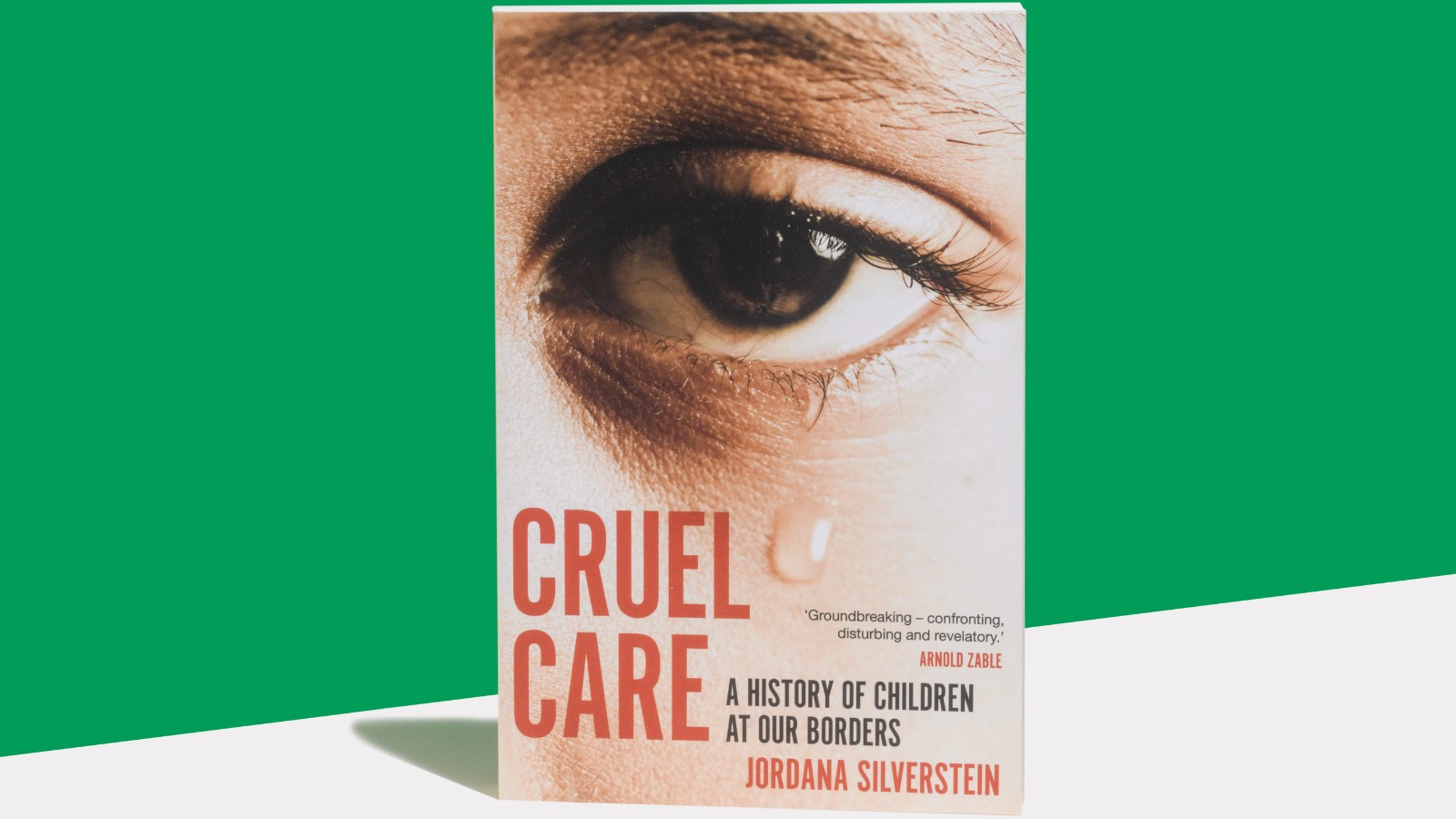VPLA 2024
Cruel Care: A History of Children at Our Borders
Non-Fiction Shortlist

Title: Cruel Care: A History of Children at Our Borders
Author: Jordana Silverstein
Publisher: Monash University Publishing
A groundbreaking examination of Australia’s treatment of child refugees.
Australia has long grappled with how to treat refugees, particularly children, who come to our country. Cruel Care asks why Australia pursues such unforgiving immigration policies, and why successive Australian governments say that the cruel acts they perpetrate are a form of care.
This is a story of government: of the politics and emotions that drive national policy. Meticulously researched – and drawing on interviews with key Australian policymakers, along with a rich set of archival sources – this book explores how legislation, ministers, political parties and the public service have combined to create a narrative of compassion while pursuing repressive policies. It details the weaponisation of rhetoric such as ‘best interests of the child’ and the histories of race – and racism – that influence Australian discourses of national security.
Cruel Care asks provocative questions about how policymakers are shaped by, and in turn shape, their histories, communities and the nation. It is a clarion call for better treatment for all who arrive on our shores.
Photography by Sarah Walker
Judges’ report
What happens when ‘politicians narcissistically imagine themselves as being both able to and required to speak for child refugees and their desire to stay alive and safe’? Refugees are depersonalised, writes Jordana Silverstein, ‘transforming them into populations to be moved, controlled, traded, punished and articulated at will.’ Cruel Care: A History of Children at Our Borders is comprehensive, sensitive and uncompromising. Offering strong foundational context from colonisation to today, Silverstein tenaciously holds policymakers to account, addressing bureaucrats and legislators as well as analysing the legacy of every immigration minister across five decades. This is a work of great national significance.
Extract
This book charts the stories that have been told by (overwhelmingly white) Australian policymakers about child refugees and asylum seekers. I sketch the current state of Australian child refugee policy, drawing on historical background to help us understand the present. By gathering up and examining the words and actions of politicians, public servants and government workers, in documents available in the National Archives of Australia, the National Library of Australia, Hansard and the media, and in oral history interviews I conducted between 2017 and 2019, I examine how immigration policies directed towards asylum seekers and refugee children function. I ask: what work do they do? What stories and ideas are they enabled by, and what do they enable and produce? What ideas of refuge and of childhood, of race, immigration, nation, family, bureaucracy, neoliberalism and government, do they instil? How are children seeking asylum leveraged by governments and public servants for political ends, and why does the public allow this to happen?
Discussions of both children and refugees are saturated with feeling, and emotion has come to play a significant role in how policies are developed and implemented. Emotion has become the lens through which governments, bureaucracies, public servants and human-rights advocates see and articulate a vision of themselves, of child refugees and asylum seekers, and of the Australian nation. This book explores those sentiments that swirl around child refugees, refugees in general, the Australian population and the management of the Australian border, and how they are adopted or co-opted by governing bodies and institutions. This is not to argue against emotional responses to an unarguably emotive subject, but to examine how emotions function, what work they do. It is not that there is no place for emotion – for grief, rage or love – in our discussions of the treatment of child refugees. Indeed, on the contrary: we will feel, and we must respond. But the sentiments with which we engage need to lead us towards justice and self-determination for refugees, rather than towards pity or control, or into a humanitarianism that generates white saviours and perpetuates the myth of a benevolent nation. They need to help us see the long histories in which we are living and acting.
For, of course, if we are to consider the way that Australia views refugee children, we need to acknowledge that not all children are seen through the same lens of emotion. Within mainstream white Australia, white citizen children are often granted more freedom to make mistakes than others. It is not that non-white children are any more likely to undertake ‘criminal’ behaviour, but that as a result of ongoing systemic racism, they are more likely to be thought of as criminals and to be punished by the state and its infrastructure. For instance, in April 2022 The Guardian reported that ‘young Indigenous people are only 5.8% of all young people aged 10–17 in Australia but make up 49% of all young people in detention’. Only four months later, in August 2022, ABC News reported that in the much-criticised youth prison in the Northern Territory, Don Dale, which was subject to a royal commission in 2016, ‘[s]ome of the children … are as young as 10 years old, almost all are Indigenous, and the majority are on remand awaiting court verdicts’. This is the result of a colonial system that is designed to stop certain children from flourishing. We will return to this point in Chapter 1.
Refugee and asylum-seeking children are understood, imagined and represented by governments and the public in various ways. More readily seen as innocent and needing rescue – including from their parents, who are often depicted as pernicious lawbreakers – they are also understood to be incapable of helping themselves, and less capable in general than citizen children. But ‘refugee children’ is not a stable category: it is used and made visible in different ways and at different times. When we look closely at government policy discourses around child refugees, including the terms that are used, and the histories, hidden meanings and agendas at play, we see the ways that governments use language to control and confine, and the at-times insidious stories their representatives tell both in the service of that work and in order to rationalise it. We see how governments have practised cruelty while claiming they are acting out of compassion and care. We see the ways they move to limit the ideas, imaginations and possibilities of how Australia responds to those seeking asylum. And we can come to understand that the history of children at our borders is fundamentally interlinked with Australia’s colonial history. We cannot grapple with the implications of border protection and its effects without first grappling with Australia’s treatment of First Nations peoples on this continent and recognising the force of Indigenous presence ‘as one of insistence and persistence’, as Munanjahli and South Sea Islander public health researcher Chelsea Watego has written. We need to reiterate, following Watego and others, that the problem is the colony and how it governs.
Of course, there are crucial differences in the ways that First Nations peoples and refugees are governed and treated, and their relationships to (being on) this land. First Nations peoples are sovereign with this land. The rest of us are colonisers, whether we like it or not. Because of Australia’s foundational settler colonialism, the formative attempt to create colonial sovereignty, every non-Indigenous act of governance in this country is settler-colonial in intent and content. That is why there can never be true justice at the border while Australia remains a settler colony.
About the author

Jordana Silverstein is a senior research fellow at the Peter McMullin Centre on Statelessness at the University of Melbourne. She has also been a visiting scholar at the ANU’s Humanities Research Centre. She is the author of Anxious Histories (2015) and co-editor of Refugee Journeys (2021) and In the Shadows of Memory (2016), and her criticism and essays appear widely in Australian publications.
Related Posts

Read
What's on in May: Resident Organisation Round Up
29 Apr 2024

Read
Anne-Marie Te Whiu Receives The Next Chapter Alumni Poetry Fellowship
2 Apr 2024

Read
What's on in April: Resident Organisation Round Up
28 Mar 2024

Read
Blak & Bright First Nations Literary Festival returns in 2024
7 Mar 2024

Read
What's on in March: Resident Organisation Round Up
29 Feb 2024

Read
Hot Desk Extract: International
23 Feb 2024
Share this content